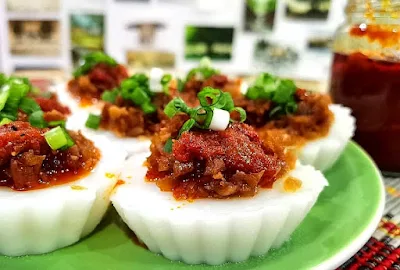Chinese steamed rice cake (水粿)
Having Chwee Kueh is a delicacy. The steamed rice cake known as Chwee kueh is a Teochew specialty. Singapore and China's Guangdong province are where this dessert was created. The Teochew people moved to Singapore in great numbers throughout the 19th century, bringing their culinary skills with them. Chwee kueh is a dish served in many of Singapore's hawker centres and is frequently associated with Singaporean breakfast.
There are numerous varieties of rice
flour-based steamed cakes. Chwee kueh, which is flavorful and quick to make,
might be wonderful to start with. Simple and inexpensive ingredients are used. Mainly
made of a variety of flour, cornstarch, and water. The steamed chwee kueh has a
texture similar to pudding that is soft, bouncy, and sticks to your fork but
magically melts in your tongue because of this. The chwee kueh has a delicate,
tiny saucer-like shape. "Chai Poh," a Chinese dried radish topping,
is placed on top and bursts with umami saltiness and lingering sweetness. If
you like your chwee kueh with more "kick," drizzle some sambal (chilli
paste) on top.
A preserved radish known as chai poh is available in two varieties: sweet and salty. I have only used the salty variety when cooking so far. It is preserved and dried veggies. The chai poh that I bought was being repackaged without a label. I thus download a photo of chai poh with the brand for you to use as a guide to buying from Asian grocery stores.
Chwee Kueh is made from a variety of
flours, as I already explained. Rice flour is the main component. The batter
will have a firm texture if you use solely rice flour. The batter, which is
comprised of corn flour or cornstarch and wheat starch, softens the kueh.
The amount of water in the batter will determine how well the Chwee Kueh turns
out. The steamed cakes will be either too firm or too soft if the proportion of
water to flour and starch is not right.
Typically, cakes are steamed in a 6
x 2 cm aluminium mould with a smooth side. But I am using an egg tart mould
that is 7 x 2.5 cm. After steaming, the rice cake must be carefully removed
from the mould by prying it away at the edges of the mould with a pointed
knife. If you are using a 6 x 2 cm smooth side mould, can make 20 pcs of Chwee Kueh. 13 pcs of Chwee Kueh can make with the egg tart mould.
After all that, is it anything you
are a little anticipating? The most stunning Chwee Kueh, which is so delectable
that you cannot stop eating it, is what I will show you how to make right now.
INGREDIENTS
Kueh
150g rice
flour
1 ½ tsp
wheat starch
1 ½ tsp
corn flour
½ tsp salt
2 tsp oil
300ml water
at room temperature
400ml
boiling water
Topping
150g minced
chai poh (dry salted radish)
1 whole
head of garlic, minced
¼ tsp dark
soya sauce
120ml
vegetable oil
2 tbsp
sugar
METHODS
1. Combine the rice flour, wheat
starch, corn flour, salt, oil, and 300 ml of water in a large bowl and whisk
until thoroughly blended and lump-free. Pour the 400 ml of boiling water in and
whisk it till smooth.
2. Once the batter has been poured
into a saucepan, placed on a gas stove, cooked over low heat, and regularly
stirred until the batter has thickened enough to coat the side of the pot. Stir
the batter until it is halfway cool after taking the pot off the gas stove.
3. Set the steamer to a rolling
boil. The bamboo steamer should be filled with tart moulds. Fill the moulds
with batter to 95% full. 20 minutes of high heat steaming. After removing it
from the heat, let it in the steamer for an additional five minutes before
opening the lid. This will stop the rice cake's top from being wet. Remove
the bamboo steamer from the steamer.
4. Right after steaming, cakes should appear mushy. Leave it on the counter to cool and set. The rice cake can be re-steamed before being served with the topping.
5. After cleaning and rinsing the
salted radish (chai poh) , give it a 10-minute soak in enough water to lessen its
saltiness. Drain in a colander and press out any extra water before
transferring to a wok with dark soy sauce and minced garlic. It was properly
combined until the chai poh, garlic, and black soy sauce were well-coated.
120ml of cooking oil should be added to almost cover the mixture completely.
Fry the garlic until golden brown and fragrant over medium-high heat. Reduce
the heat to low, add the sugar and whisk until it dissolves. Turn off the heat,
taste, and season as needed.
6. Remove the chwee kueh from the
mould and add the fried chai poh on top. If you prefer your chwee kueh to taste
spicy, serve it with sambal (shrimp chilli paste) or any hot sauce.
Hope you find this guide useful and
enjoy this super soft, pudding-like chwee kueh topping with that umami
saltiness and lingering sweetness “Chai Poh”.







Comments
Post a Comment